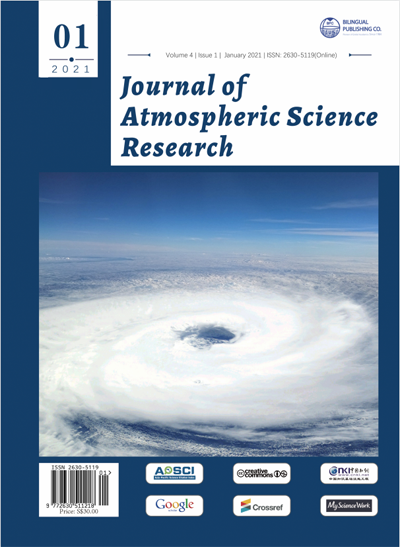-
2081
-
1501
-
1495
-
1366
-
1230
Bioclimatic Regularities of Change in the Density of Organic Carbon of the Steppe Soil in Different Regions of the World
DOI:
https://doi.org/10.30564/jasr.v4i1.2521Abstract
The bioclimatic regularities between the average annual precipitation, average annual temperatures and the density of organic carbon in the soil layer of 0-30 cm of the steppes in the regions of the world are given. They are distinguished by a high certainty of quantization by asymmetric wave equations. It turned out that, due to the vibrational adaptation of organic carbon, precipitation and temperature are dependent on each other. For example, the model of the influence of precipitation on temperature includes the first term in the form of Laplace’s law (in mathematics), Mandelbrot’ law (in physics), Zipf-Perl (in biology), and Pareto (in econometrics). The second term is the biotechnical law of the author of the article, which gives the maximum change in the indicator. Both components form a trend that makes it possible to divide the precipitation interval into three stages: (1) with an increase in precipitation from 0 to 60 mm, the temperature decreases according to Mandelbrot’s law from 23.25 to 0.5 0С; (2) from 60 to 2100 mm, the temperature rises to 24 ° C; (3) with a further increase in precipitation over 2100 mm, a slow decrease in temperature occurs. The third term is an asymmetric wavelet with a constant half-period of 367.8 mm. A positive sign shows that in the steppes there is a positive oscillatory adaptation of temperature to changes in precipitation. In the interval of precipitation 0-350 mm, an oscillatory decrease in temperature occurs. It turns out that the first oscillation at 0 mm precipitation begins with a very high temperature gradient of thermal energy. The first interval includes Mongolia and Inner Mongolia. In the second interval of 350- 750 mm, an oscillatory increase in temperature occurs. Then, in the third interval 750-1050 mm, the temperature drops again. The second oscillation with a correlation coefficient of 0.9685 has clear precipitation boundaries in the range of 200-2000 mm. Due to the negative sign, the fluctuation is a crisis, inhibiting the rise in temperature. And the third fluctuation has a positive effect on the temperature. The mechanism of oscillatory adaptation in the steppe soil is so perfect that it changes for itself the conditions of the place where the grass grows. An amplitude-frequency analysis of each oscillation will make it possible to determine the specific particular effects of precipitation and temperature on each other and on the density of organic carbon. It was found that two-factor modeling of the change in the soil organic carbon density makes it possible to achieve an identification error even less than the absolute measurement error.
Keywords:
Regions of the world, Steppes, Soil, Organic carbon, PatternsReferences
[1] Mazurkin P.M. Land plots of federal districts of the Russian Federation. Success of modern natural science, 2020. No. 4. S. 106-113. (in Russia). DOI: https://doi.org/10.17513/use.37370
[2] Mazurkin P.M. Land plots of the Siberian Federal District of Russia. Success of modern natural science, 2020(6): 75-82. (in Russia) DOI: https://doi.org/10.17513/use.37414
[3] Mazurkin P.M., Mikhailova S.I. Territorial ecological balance: analyte. overview. Novosibirsk: GPNTB SO RAN, Ser. Ecology., 2010(94): 430. (in Russia)
[4] Reimers N.F. Nature management: Dictionary-reference. M.: Mysl’, 1990.637 p. (in Russia)
[5] Saati T. Decision-making. Hierarchy analysis method. M.: Radio and communication, 1993: 274. (in Russia)
[6] Tairov A.D. Climate changes in the steppes and forest-steppes of Central Eurasia in the II-I millennium BC: Materials for historical reconstructions. Chelyabinsk: Rifey, 2003: 68. (in Russia)
[7] Chibilev A.A., Velmovsky P.V., Grudinin D.A. From the transformation of nature to the optimization of landscapes: “experiments” by F.N. Milkov and the testament of F. Engels. Questions of steppe studies. Orenburg: IS UB RAS, 2018(XIV): 45-51. (in Russia). DOI: https://doi.org/10.2441/9999-006А-2018-00002
[8] Fischer G., Velthuizen H., Shah M., Nachtergaele F. Global Agro-ecological Assessment for Agriculture in the 21st Century: Methodology and Results. International Institute for Applied Systems Analysis, Laxenburg, Austria. Food and Agriculture Organization of the United Nations. Rome, Italy. 2002. URL: http://webarchive.iiasa.ac.at/Research/LUC/SAEZ/index.html
[9] Mazurkin P.M. Wave patterns of annual global carbon dynamics (according to information Global_Carbon_Budget_2017v1.3.xlsx). Materials of the International Conference “Research transfer” - Reports in English (part 2), Beijing, PRC, November 28, 2018: 164-191.
[10] Mazurkin P.M. Wavelet analysis of annual dynamics of maximum temperature from 1878 to 2017 and forecast data Hadley center Central England temperature (Hadcet). International Journal of Current Research, 11(09), 7315-7324. DOI: https://doi.org/10.24941/ijcr.36626.09.2019
[11] Mazurkin P.M., Kudryashova A.I. Quantum meteorology // International Multidisciplinary Scientific GeoConference Surveying Geology and Mining Ecology Management, SGEM, 2019, 19 (5.1): 619- 627. DOI: https://doi.org/10.5593/sgem2019/5.1/S20.077
[12] Zhao Y., Ding Y., Hou X., Li F.Y., Han W., Yun X. Effects of temperature and grazing on soil organic carbon storage in grasslands along the Eurasian steppe eastern transect. PLoS ONE. 2017, 12(10). DOI: https://doi.org/10.1371/journal.pone.0186980
Downloads
How to Cite
Issue
Article Type
License
Copyright © 2021 Author(s)

This is an open access article under the Creative Commons Attribution-NonCommercial 4.0 International (CC BY-NC 4.0) License.




 Peter M. Mazurkin
Peter M. Mazurkin





